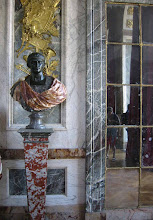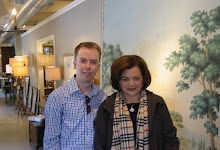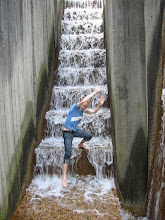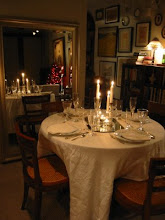 One of the grandest monuments in DC which dominates the skyline is the National Cathedral, also known as the Cathedral Church of St Peter and St Paul (Episcopalian). As the 2nd largest church in the United States and 6th in the world, that comes as no surprise. It also holds the record as the highest point in DC, a fact that's easy to believe when you stand on the 7th floor observation deck surveying the entire city!
One of the grandest monuments in DC which dominates the skyline is the National Cathedral, also known as the Cathedral Church of St Peter and St Paul (Episcopalian). As the 2nd largest church in the United States and 6th in the world, that comes as no surprise. It also holds the record as the highest point in DC, a fact that's easy to believe when you stand on the 7th floor observation deck surveying the entire city! The idea was rooted in Pierre L'Enfant's 1791 plan of DC for the need of a church of national significance. It wasn't until 1907 that construction began (with President Theodore Roosevelt presiding the foundation laying ceremony) and the Cathedral was officially 'finished' in 1990 with President George H W Bush in attendance. It has indeed been of national importance as it has been host to numerous state funerals and memorial services.
The idea was rooted in Pierre L'Enfant's 1791 plan of DC for the need of a church of national significance. It wasn't until 1907 that construction began (with President Theodore Roosevelt presiding the foundation laying ceremony) and the Cathedral was officially 'finished' in 1990 with President George H W Bush in attendance. It has indeed been of national importance as it has been host to numerous state funerals and memorial services. The original architect was Frederick Bodley, a well-known English architect, who was replaced upon his death after WWI with Philip Hubert Frohman - who developed and expanded upon the original plans. Much like it's predecessors, the great European middle age cathedrals, the style is primarily gothic. However, the difference lies in the fact that while the churches in Europe were built over centuries (explaining their varied styles throughout the buildings), the national cathedral was purposefully built as a 'hodgepodge' to appear like the precedents: So a 'fake' evolved style if you will. It makes it all the more interesting!
The original architect was Frederick Bodley, a well-known English architect, who was replaced upon his death after WWI with Philip Hubert Frohman - who developed and expanded upon the original plans. Much like it's predecessors, the great European middle age cathedrals, the style is primarily gothic. However, the difference lies in the fact that while the churches in Europe were built over centuries (explaining their varied styles throughout the buildings), the national cathedral was purposefully built as a 'hodgepodge' to appear like the precedents: So a 'fake' evolved style if you will. It makes it all the more interesting! What I love most about the building though is that while it is rooted in the gothic cathedral tradition, there is a lot of our modern world at play. Many of the stained glass windows and sculptures depict our modern age: robots, space travel and even Darth Vader!
What I love most about the building though is that while it is rooted in the gothic cathedral tradition, there is a lot of our modern world at play. Many of the stained glass windows and sculptures depict our modern age: robots, space travel and even Darth Vader! The National Cathedral is, to me, an Opera of a building. By that I mean it combines all the arts into one package: secular and religious, modern and antique, embroidery, stained glass, architecture, sculpture, gardens, painting. You name it, they have it. Not to mention the views of the city!
The National Cathedral is, to me, an Opera of a building. By that I mean it combines all the arts into one package: secular and religious, modern and antique, embroidery, stained glass, architecture, sculpture, gardens, painting. You name it, they have it. Not to mention the views of the city! Now for some of the delicious details. The one side transept (I forget which and both are different) has this beautiful blue ceiling. I love the juxtoposition of patterns! In the pictures above, you almost sense the scale of the space, ENORMOUS. I love the groin vaulting in the ceiling and the way the stained glass adds so much color to the Indiana Limestone interior.
Now for some of the delicious details. The one side transept (I forget which and both are different) has this beautiful blue ceiling. I love the juxtoposition of patterns! In the pictures above, you almost sense the scale of the space, ENORMOUS. I love the groin vaulting in the ceiling and the way the stained glass adds so much color to the Indiana Limestone interior. Like all good gothic cathedrals, here are the flying buttresses behind the rear chapel.
Like all good gothic cathedrals, here are the flying buttresses behind the rear chapel. I loved the adjoining buildings of the cathedral school - like an old English country manor!
I loved the adjoining buildings of the cathedral school - like an old English country manor! The basement level is of course a bit gloomy, but full of as many details and workmanship as the rest of the cathedral. I loved this view looking up the stairs into the main church.
The basement level is of course a bit gloomy, but full of as many details and workmanship as the rest of the cathedral. I loved this view looking up the stairs into the main church. In this capital on the outside, you see a bit of the modern 'edge' - a robot amongst the figures!
In this capital on the outside, you see a bit of the modern 'edge' - a robot amongst the figures! As our national cathedral, much of our countries history is depicted. This statue of Abraham Lincoln rests in the front of the nave.
As our national cathedral, much of our countries history is depicted. This statue of Abraham Lincoln rests in the front of the nave. Above one of the interior front doors is Eleanor Roosevelt among some others who are celebrated for their good work.
Above one of the interior front doors is Eleanor Roosevelt among some others who are celebrated for their good work. I loved this modern iron gate down in the basement. The handle is a large iron hummingbird.
I loved this modern iron gate down in the basement. The handle is a large iron hummingbird. The craftsmanship of everything in the building is breathtaking. Even this simple handrail is so elegant.
The craftsmanship of everything in the building is breathtaking. Even this simple handrail is so elegant.  Thousands of hand embroidered cushions fill the space -each one amazing in its' own right. This one fits with the space travel themed stained glass windows.
Thousands of hand embroidered cushions fill the space -each one amazing in its' own right. This one fits with the space travel themed stained glass windows.
Now you can't say "They don't build them like they used to"; 'They' still do - occasionally!
All photos taken during my visit last weekend, May 15th, 2010.










































.JPG)








































































22 comments:
Those photos are really great. As for your remark, I think that the face of architecture has changed because people do not build for god but for themselves, so they aim lower.
(Of course there are some really dedicated architects, but that`s an exception not the rule.)
thegoldenmist.blogspot.com
Interesting points, golden mist. I would argue back though that the cathedrals built back in time were also built for themselves and the prestige they brought their cities. However, I very much think you're correct that the workmen on the projects were doing their work for God's glory rather than their own. The depresssing thing about that, to me personally, is that all of the artwork at this cathedral is signed and named...where as in the past everything was anonymous and for god unless it was particularly important.
It's an interesting design, but somehow leaves me cold (that could also be due to the fact that I'm Catholic, and don't care for these godless king-worshippers!). My late neighbor (born in 1901) remembered going to the laying of the cornerstone for the Cathedral.
One correction, it's in honor of St. Peter and St. Paul, not Matthew.
Great images. I was at our local cathedral this morning. It's a brutalist structure built in the 1950's and already it's having structural problems.
I love gothic cathedrals. Have you read Pillars of the Earth? Wonderful post, you always explain it all so well.
Thanks Laura! I actually just read that LONG book recently -really fascinating, although it did take me a few (hundred) pages to really get into it. I'm debating reading the book that follows it. Have you read it?
How could that creativity leave anyone cold?! It absolutely took my breath away. Bad or good, it IS art. How lucky for you to get to be in its presence. You were right to say, "They don't build them like they use to". Thanks for sharing those images.
Best regards,
Reynolds Still
www.reynoldsstill.blogspot.com
Stefan - Oddly enough I was at the Cathedral this morning showing a friend around. The architecture, both exterior and interior, is amazing, but my favorite spot is actually the Bishops' Garden - its like a little piece of the English countryside in DC. Just one point. The "robot" is actually one of a series of native american spiritual figures carved on that particular column (don't quote me, but I think it is Mayan). Love the blog! keep up the great work. JAC
The depressing thing about that, to me personally, is that all of the artwork at this cathedral is signed and named...
Stefan --
Some decades ago, I nearly incited a fist-fight up in Boston when I remarked that I hoped I would live long enough to see one of I.M Pei's buildings torn down.
Now that the East Wing of the National Gallery is being disassembled, at a cost of -- what? -- eighty million to the taxpayers, I feel obliged to point out that none of those stones are signed.
Best, etc.
Jack, thanks for the information about the capital -mayan:cool!
Ancient -each individual stone is not signed - of course not. However there are signatures at places around the building (pointed out to us on a tour) as well as many of the faces of the masons carved into different areas. The building is marvelous, I'm not deriding it, I'm simply stating my opinion as you are yours.
The East wing is interesting. For those who aren't familiar - the east wing, by I M Pei has had the problem of stone falling off the facade. All of the stone must be removed and re-attached using a different system as the previous one has failed. It's unfortunate but probably more the fault of the structural engineer than IM Pei. I have to admit I've always loved that building and I'm glad they're 'restoring'it -but a restoration after 20 years is VERY unusual and unfortunate.
The National Cathedral is one of the sites I have yet to see in D.C. I cannot wait to go now after this great posting. Thanks, Denise
We younger two Darling children spent many hours playing in the Bishop's Garden and the Cathedral itself. In those days the Purple Ladies (as we called the docents)tolerated our presence as long as we were quiet and avoided private and sacred spaces.
As a student at NCS I spent every friday morning at chapel in the choir stalls. My 4th grade history class was was doing a tour of the Cathedral when a docent came up and announced that President Kennedy had been shot. It was the first time I remember seeing an adult cry.
The Bishop's Garden was wonderful to play in and had a charming giftshop called the Herb Cottage where a lot of Darling allowances got spent. Just down the hill is the Herbert Heseltine equestrian statue of George Washington that my parents thought (the horse, not George) was excessively male...
Our Siamese cat, Lucy, moved up the street to live with the Frohmans. Mr Frohman was a shadowy, elserly figure by that point and disn't make much of an impression, but his much younger wife was a real character, and Reggie was a favorite of hers. She had a pearl handled revolver which she threatened to use if any mobs came up 35th St during the race riots of the 60s. Lucy the cat dis end up immortalized in stone, but if I recall correctly not on the Cathedral proper, but rather in the College of Preachers.
Hermione Darling
Hermoine, thanks so much for sharing your memories and making the cathedral come alive in our eyes!
I noticed the same...eh-hem...manhood on the horse and was a bit disturbed myself! They spent too little time sculpting George and spent too long on the horse. I'm sure there is a story there. A sculptor who didn't get paid or something.
Stefan, No matter the subject your descriptions are the next best thing to being there! Thanks for this post.
Stefan, I love this description, "The National Cathedral is, to me, an Opera of a building. By that I mean it combines all the arts into one package: secular and religious, modern and antique, embroidery, stained glass, architecture, sculpture, gardens, painting." Great post!
Beautiful post! I lived on Garfield Street, across the Cathedral, as a child, and have many fond memories of visiting the Cathedral as well as the Bishop's Garden (and the gift shop!).
My mother's ashes are buried in the courtyard of St. Alban's, so the area continues to be a special place to me.
Years back and at the National Cathedral, I had afternoon tea in an upper room which provided stunning views of the area. I wonder if this opportunity continues to be available? It was a lovely time!
Stefan - thanks for all the details and pics - and the interesting additions from all your readers. I've never been there -but it's on my list! As far as the concept of building for the glory of God - my view is always that anytime someone creates art - whether it's a building or an opera - a thing of beauty is in and of itself a glorious gift - both from the artist and too the artist. (if that makes any sense)
You are so great at "taking us there" and unveiling the little details. I love the gate/window/and Eleanor....Thanks...K
Hi Stefan, I've returned to your blog after too long in a self-imposed cultural desert! It's your affectionate eye for detail that makes your posts so delightful.
Great blog. You shared best images of National cathedral. In photo have impressing design. You give nice information about this church is 2nd largest in united states and 6th in world.
Hello... I so appreciate your enjoyment of Washington National Cathedral. The photos are beautiful. I am a docent there, and would like to offer some corrections to what's been said here, and hope it will not be taken as making you wrong. To your credit, their aren't many.
The vaulting in the main ceiling, as with most of the chapel ceilings is ribbed vaulting, not groin vaulting. For comparison, there are examples of groin vaulting in certain spaces of the lower level, like the halls outside St. Joseph of Arimathea Chapel, in Resurrection Chapel and an example of pointed groin vaulting in what is now called the Visitor's Lounge. Frohman knew the lower levels of some ancient Gothic cathedrals were even older buildings, so he tried to include styles preceding that which is seen on the main level, throughout the lower.
The blue ceiling is the underside of the south transept balcony and, along with the underside of the north transept balcony, was painted by Carl Tucker. Carl knew that most of the ancient Gothic cathedrals were fully and riotously painted, once they were completed. In most cases, that paint has been gone for centuries, which is why are minds think of Gothic interiors as stone colored. Carl used to bug Clerk of the Works, Richard Feller... "When are we going to start painting it?"
Eventually Feller allowed Carl to paint the undersides of the two transept balconies, adding, "You have painted before, haven't you Carl?"
"Oh, yeah," replied Carl. He confided to me, years later, "I just didn't tell them the only tools I'd ever used were a roller and a pan."
Carl hand drew everything seen on these painted ceilings. Despite the repetitions of pattern, Carl chose to use no stencils. He also taught himself to carve lettering into wood, and is responsible for most of the engraved lettering in the wood structures of the building. Carl was a genuine, polymath genius. He was a flutist with the National Symphony Orchestra, who walked in the door one day, saw some guy building a wooden screen and asked, "Can I help you do that?" He was probably the most brilliant engineering mind who ever walked the cathedral close. He maintained all the antique clocks on the property, helped engineer the modernized pointing machine for stone carving, etc. He was a delightful man to know.
The last and most important thing I want to correct is that the "robot image" in the column capital is definitely not a robot. That column capital, by sculptor Heinz Warneke, is about the cultures of the native Americans of the desert southwest. What you are referring to as a robot is actually a sacred Hopi figure... one of the Kachinas.
Post a Comment